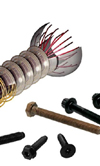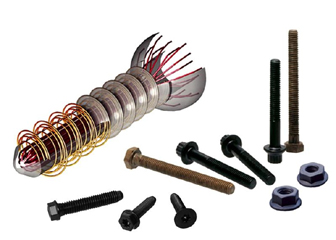Composite fasteners, part 2
 In the previous article on fasteners, we looked at a very clever design of threaded fastener that used a composite shank with the threaded portions of the component still produced in high-strength metallic materials. Not only do these fasteners use a polymer-matrix composite shank but, being made of multiple parts, they are, in the broader sense of the definition, a composite component.
In the previous article on fasteners, we looked at a very clever design of threaded fastener that used a composite shank with the threaded portions of the component still produced in high-strength metallic materials. Not only do these fasteners use a polymer-matrix composite shank but, being made of multiple parts, they are, in the broader sense of the definition, a composite component.
A European company has developed a new form of composite fastener that is a pure polymer-matrix component. Used in a number of applications initially, the company isn't actively marketing to the motorsports or other industries, choosing instead to focus on its largest market, the medical industry.
There are a number of applications where these screws would be of use in motorsports powertrains. In quasi-static low stress applications where a steel, titanium or aluminium screw might be over-engineered, a high-strength polymer fastener might be a good alternative.
The properties of polymers make them useful for many applications. In general, polymers are poor conductors, both of heat and electricity, and this makes them an attractive prospect for high-voltage systems and where we would like to restrict the flow of heat. In Formula One, the engine rules state, "All threaded fasteners must be manufactured from an alloy based on cobalt, iron or nickel"; however, in other race formulae, such polymer fasteners could find use in engines.
The problem with pure polymer fasteners is that they are very weak compared with a metallic fastener, so the concept of reinforcing the part with a fibre has a lot of technical merit. The company mentioned above has a manufacturing method by which the core of the fastener is reinforced longitudinally, and the threads are also reinforced by fibres that run helically inside the threads. This provides a much stiffer and stronger structure than would be provided by a pure polymer component.

The matrix material used is a high-strength, semi-crystalline polymer that has good properties at high temperature - the parts can be used at close to 200 C, making them suitable for many applications for design engineers. The fibre used is carbon, although there is no particular reason why it can't be replaced by other fibres. The fact that the fibres are surrounded entirely by the matrix and are not present at the contacting surfaces (underhead and threads) of the component means the parts maintain their electrically non-conductive properties, despite having a conductive reinforcement.
With many polymer fasteners, the options for manufacture are to machine from solid or mould the finished item directly. In terms of a conventionally moulded part, the options for reinforcement are to mould using a material with short fibres that can be used with injection-moulding equipment. However, the advantage of these particular fasteners in terms of mechanical properties, as the accompanying diagram shows, is that they have continuous long-fibre reinforcement running through the length of the part. While the volume fraction of reinforcement is less than we would find in a short-fibre injection-moulded part, the fibres are oriented in a much more favourable direction for load transfer.
Fig. 1 - The diagram shows the orientation of fibres in a typical screw, along with some of the component forms available
Written by Wayne Ward